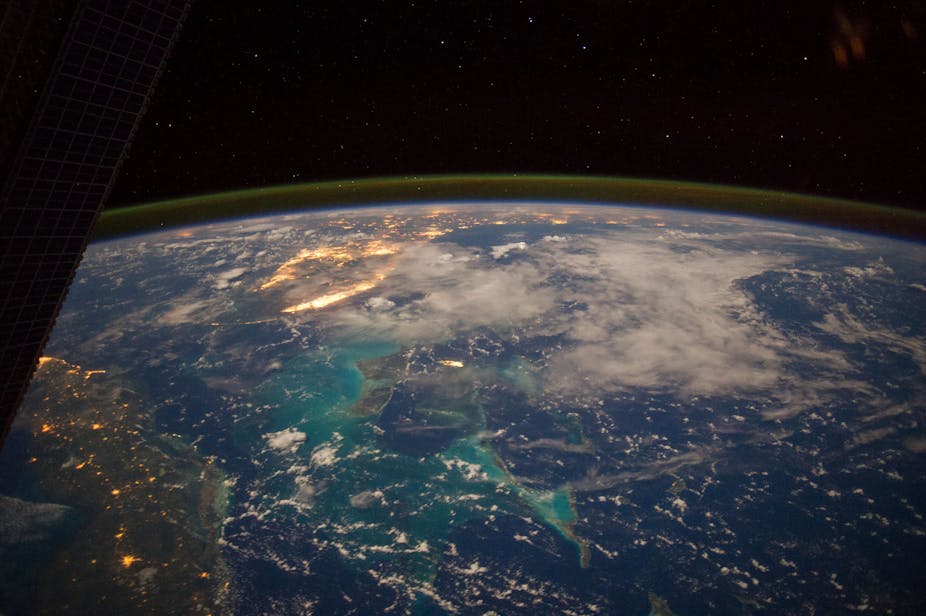“But who do you think’s right, Prof? The optimists or the pessimists?”
At the end of my sustainability economics course in 2007, students were challenging me to end 20 years of professional fence-sitting. My whiteboard showed two graphs with contradictory messages about the long-run, environmental sustainability of global industrial development, the big question that’s nagged me ever since teenage exposure to Paul Ehrlich’s Population-Bomb eco-doomsterism.
After much wrestling with the contradictions, I and my colleague Paul Burke have come up with a qualified answer: sustainability is possible over the next century, but only if we control climate change. The results were published this month in Ecological Economics.
Swimming or sinking?
My first graph showed the World Bank’s Adjusted Net Saving (ANS) indicator, which has declined, but stayed reassuringly, optimistically positive over the last 30 years. It calculates the percentage of global GDP saved, after adjustments including depreciations of capital equipment and environmental resources. Using approximate economic theory that I’d helped to establish, it is economists’ preferred indicator of sustainability.

The other graph was “Ecological Reserve”: the fractional surplus of global biocapacity above WWF’s well-known Ecological Footprint. It starts negative in 1975, and heads relentlessly downwards to ever-worsening “ecological overshoot”, threatening sustainability — or so pessimists say.

Helped by Paul, another year-2007 student, I started a paper about these opposing sustainability indicators, to address his classmates’ question.
Putting it together
The first step was easy and surprisingly new. Just show the graphs together, including the very different weights they give to current, global CO2 emissions, which cause future global warming damage: a tiny downward CO2 shift in Adjusted Net Saving, but an ever-deepening plunge in Ecological Reserve from comfortably positive to worryingly negative.
But then I went further, by choosing to build a single, hybrid indicator of global sustainability that would, I hoped, carefully temper optimism with pessimism, and thus answer the question directly.
Our hybrid indicator both extended Adjusted Net Saving, to include fairly conventional valuations of the benefit of technological progress and the cost of population growth, and changed it, to better reflect climate scientists’ deep concerns about likely future warming damage (see also here).
We considered including other global threats like biodiversity loss and rising income inequality, which many people view as unsustainable; but even measuring, let alone modelling, these variables at a global level proved too contentious.
Dicing with climate change
For our climate concern, we wanted different valuations for the future warming damage from a tonne of CO2 emitted now under controlled or uncontrolled future emissions, with both valuations far above the World Bank’s seemingly tiny $7 per tonne of CO2.
After much debate, we modified the well-known DICE model of global climate-economy interactions. We changed key assumptions in it, particularly about warming damage, so that the stringent emission control needed to meet the agreed UN target of 2C maximum global warming would be regarded as economically justified — which it is not, according to DICE’s standard results.
We did so after studying a vocal minority of climate analysts (see also here), which persuaded us that the uniqueness and long time-scale of human-induced climate change means warming damage is, and will remain, highly unknowable. Therefore, working backwards from the 2C target is as valid as the guesswork behind all direct economic estimates of future climate damage.
Climate can be a limit to growth
Our final results were fairly common sense, but unusual in giving qualified support to both optimism and pessimism.
If future CO2 emissions are controlled to limit warming to 2C, as is “optimal” in our modified climate-economy model, then our Adjusted Net Saving in 2005 is much higher than the World Bank’s number, thanks to our including the value of technological progress. Sustainable future growth in average well-being thereby looks much likelier.
But if emissions are uncontrolled, the future looks bleak. Adjusted Net Saving is firmly negative in 2005, and average well-being in our modified model falls after 2065. This contrasts with DICE’s standard result that not controlling CO2 barely touches growth in well-being.
Finding any such limit to growth in a conventional climate-economy model, albeit with much-modified parameters like ours, is actually quite rare.

Believe it… or not
Our more general conclusions are thus uncomfortable ones: on the limits to growth, to economics, and to knowledge.
Crossing “planetary boundaries”, such as for greenhouse gas concentrations, may have consequences for humanity disastrous enough to halt growth in personal wellbeing.
Nevertheless, economic modelling is useful to check that environmental policy is not driven solely by physical boundaries, and includes key human inputs like saving, technology and population growth in a reasonably coherent framework.
But our civilisation’s experiment with Earth’s environmental resources is unique, and that limits what economics or any other discipline can say. The effects of many decisions taken now will stay highly uncertain for decades or centuries. So academic policy guidance on long-run global sustainability will always contain much guesswork.
Given this unknowability, risk-averse policymakers will probably believe some physical, planetary boundaries do need to be taken seriously, as in our calculations.
But risk-loving policymakers will probably believe human ingenuity will solve all serious environmental problems, as it has been doing − so they would argue − for at least 200 years. And no one can easily prove their beliefs false.

